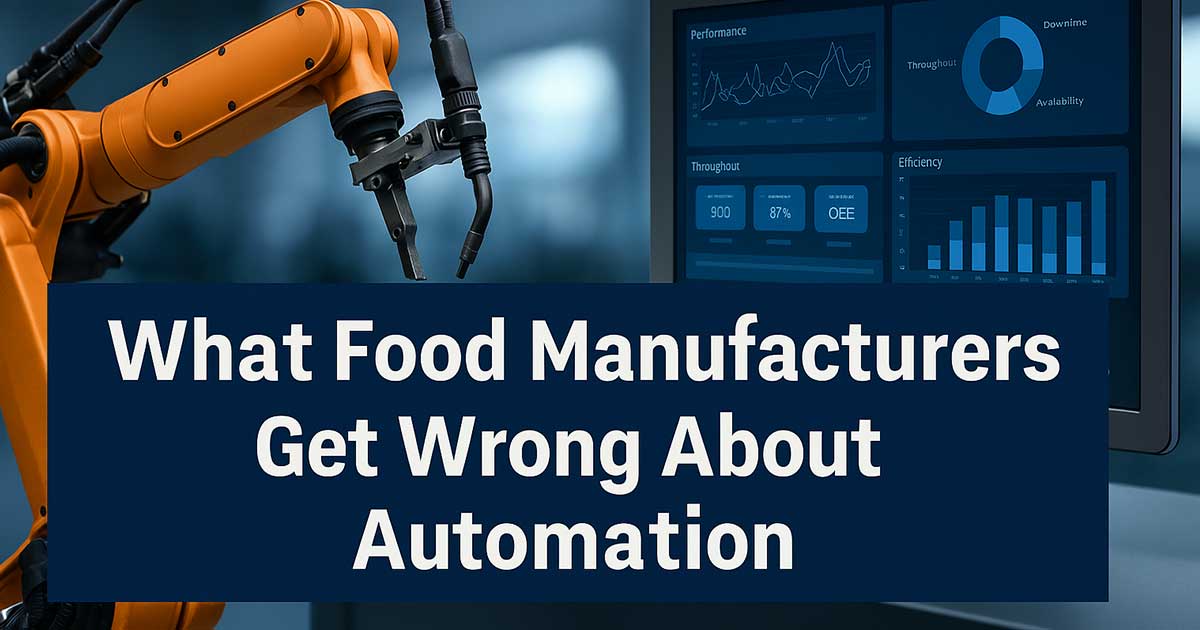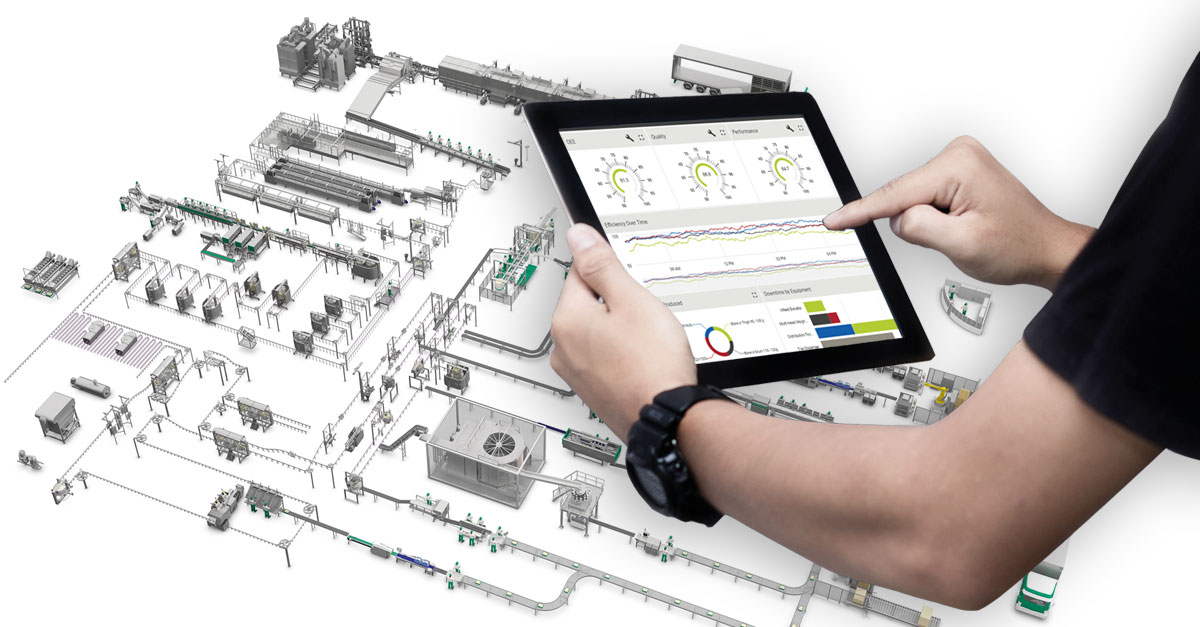In the race to modernize operations, many food manufacturers equate automation with hardware. They invest in robotic arms, automated conveyors, and high-speed packaging systems — expecting a fast return on investment through increased output and reduced labor.
But here’s the reality: hardware alone doesn’t guarantee efficiency. Without the right software infrastructure in place, even the most advanced machines can fall short of expectations.
The Misconception: Automation = Equipment
When manufacturers think of automation, they often visualize equipment — not execution. While hardware plays a critical role, it’s the software layer that synchronizes operations, collects data, and turns machine activity into measurable results.
Without software like a Manufacturing Execution System (MES), plants can struggle with:
-
Manual data entry and duplication
-
Poor visibility into production performance
-
Bottlenecks that quietly erode throughput and profitability
-
Inconsistent quality or yield loss
-
Ineffective use of labor and equipment
What Is MES and Why Does It Matter?
A Manufacturing Execution System (MES) connects your plant floor to your decision-makers. It captures real-time data across production lines, monitors performance, and delivers insights that help teams:
-
Reduce downtime
-
Optimize labor allocation
-
Track yields and waste
-
Ensure food safety and traceability
-
Respond faster to changes in demand or resources
Instead of relying on spreadsheets, whiteboards, or gut instinct, MES provides a centralized source of truth for operational performance.
In many cases, the necessary data infrastructure already exists. MES can interface with sensors already built into your equipment, or leverage cost-effective wireless sensors to gather production data. Connecting this data to an MES platform unlocks hidden insights without requiring capital investment in new hardware.
The Core Functions of MES in Food Manufacturing
To understand the true value of MES, it helps to look at its core functions:
1. Production Scheduling & Order Execution
MES receives orders from your ERP system and breaks them down into actionable tasks, allowing operators to execute production with clear priorities and instructions.
2. Real-Time Performance Monitoring
Operators and supervisors can view dashboards displaying throughput, downtime, yield, and efficiency in real-time. Problems are identified and corrected faster.
3. Quality & Compliance
MES systems often include tools for capturing quality checks, monitoring temperatures, and maintaining full audit trails for food safety compliance.
4. Traceability & Recall Management
Modern MES platforms can trace ingredients, packaging, and finished goods through every stage of production. If a recall occurs, you can respond in minutes rather than days.
5. Inventory & Yield Tracking
Track raw materials and finished goods across the plant. Calculate true yields and losses by batch, line, or shift to uncover hidden inefficiencies.
Case Study: Gedik Piliç Improves Performance Without Adding Labor
A powerful example of MES in action comes from Gedik Piliç, a leading poultry processor in Turkey. The company implemented CAT Squared’s MES in both its primary and further processing facilities. The result?
“We were able to increase our production in normal working hours (without overtime) from approximately 1,000 tons per month to 2,000 tons per month.”
This outcome highlights how improved operational visibility and control can help plants maximize capacity using existing resources — without needing to expand shifts or increase labor.
MES vs ERP: What’s the Difference?
Some food manufacturers assume their ERP system can handle plant operations. While ERP is essential for business processes like finance and procurement, it lacks the real-time responsiveness and shop floor focus of MES.
| ERP | MES |
|---|---|
| Business-level planning | Real-time production execution |
| Finance, HR, supply chain | Line performance, downtime, yield |
| Daily or weekly updates | Instant, continuous data collection |
MES complements ERP by executing what ERP plans — making the strategy actionable at the plant floor.
MES Turns Labor Into a Strategic Asset
Many food plants have valuable employees spending hours on repetitive tasks like paperwork and data entry. MES eliminates that inefficiency, freeing up time for more strategic activities like process improvement, training, and quality assurance.
For example, eliminating 120 hours of manual data entry per week at $25/hour frees up over $150,000 per year — without reducing headcount. Those hours are reallocated to work that directly improves safety, output, or profitability.
Real-World Impact of MES: What the Data Shows
Companies that implement MES as part of their digital transformation strategy typically see:
-
A 20% or more improvement in overall equipment effectiveness (OEE)
-
Up to 30% reduction in waste thanks to improved quality tracking
-
ROI often realized within the first 6 months
-
Fewer unplanned outages due to smarter maintenance schedules
MES also allows for smarter, data-driven preventive maintenance that reduces unplanned downtime, extends equipment life, and reduces the cost of reactive repairs.
Starting Small: Why Pilot Projects Work
One of the best ways to get started with MES is through a focused pilot project. By selecting a specific area of production to monitor — such as yield tracking or downtime analysis — plants can generate measurable ROI without disrupting the entire operation. These early wins build confidence and provide a strong foundation for future expansion.
A Cultural Shift That Pays Off
Implementing MES isn’t just about technology — it’s about people. When teams have access to real-time data, they make better decisions faster. MES supports a culture of continuous improvement by empowering everyone on the plant floor to contribute to performance gains. The result? A more agile, more resilient operation.
The Takeaway: It’s Not Hardware or Software — It’s Both
True automation in food manufacturing is a balance of smart equipment and smarter execution.
If your plant is investing in hardware without a strong MES foundation, you may not be getting the full return on your investment. On the other hand, MES can help you scale production, reduce costs, and improve traceability — even with your current equipment and team.
Ready to Learn More?
Discover how CAT Squared’s MES platform can help you modernize your food processing plant — without the need for expensive new equipment.
Download the Gedik Case Study
Contact Us
tellmemore@catsquared.com




